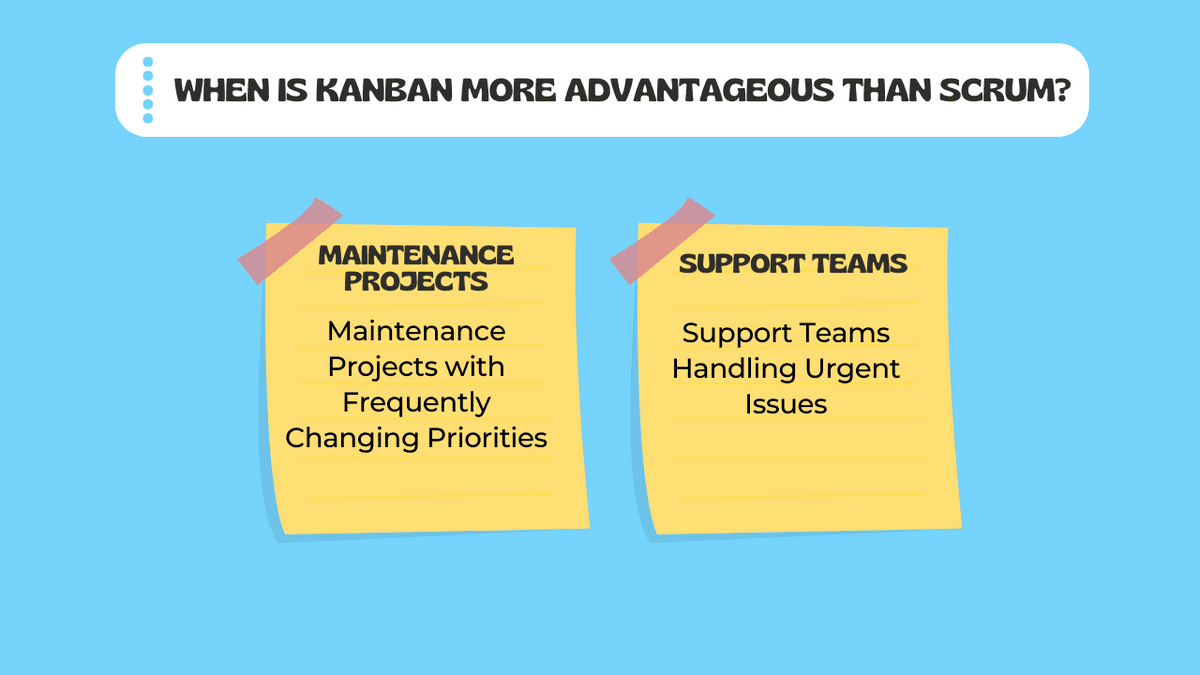
Choosing Wisely: When is Kanban Better than Scrum?
 When is Kanban Better than Scrum?
When is Kanban Better than Scrum?
In the Agile world, two popular frameworks, Scrum and Kanban, are often at the center of discussion.
While both Kanban and Scrum offer their unique advantages, there are definite situations where one outshines the other. For maintenance projects and support teams where priorities can shift quickly, Kanban's focus on flow and adaptability often makes it the superior choice.
However, the final decision between Kanban and Scrum should always be tailored to your team and project's specific needs. In this article, we'll discuss when it's advantageous to use Kanban instead of Scrum for managing your projects.
Table Of Contents-
Understanding Kanban
Kanban is an Agile methodology that visualizes the entire project on a board, allowing for a clear view of work status and progression.
Kanban puts a strong emphasis on flexibility and continuous delivery, while Scrum is based on time-boxed sprints with a set amount of work to complete.
It doesn't work in iterations like Scrum but instead focuses on continuous improvement in a flexible manner.
Brief overview of the differences between Kanban and Scrum
The primary difference between Kanban and Scrum lies in their fundamental principles.
Kanban puts a strong emphasis on flexibility and continuous delivery, while Scrum is based on time-boxed sprints with a set amount of work to complete.
While both methodologies aim to improve team productivity through incremental iterations, they do so in different ways. In this article, we compare Kanban and Scrum framework in detail.
Let us look at the situations where Kanban outshines Scrum and results in better productivity.
Situations where Kanban Shines
-
Frequent Changes or Updates: If your project encounters constant changes or priority shifts, Kanban's flexible nature allows for seamless integration of new tasks.
-
Maintenance or Support Projects: For teams managing ongoing maintenance or support tasks that don't have a definitive timeline, Kanban provides an efficient framework for handling and prioritizing tasks.
-
Small Teams: Kanban's flexibility is particularly beneficial for small teams where roles and responsibilities often overlap, and the process needs to adapt quickly to changes.
Real-world Scenarios: When is Kanban More Advantageous than Scrum?
Here, we explore real-world examples where Kanban's flexibility outshines Scrum's structured approach.
 Real-world Scenarios: When is Kanban More Advantageous than Scrum?
Real-world Scenarios: When is Kanban More Advantageous than Scrum?
Maintenance Projects with Frequently Changing Priorities
Maintenance projects inherently involve unexpected work that surfaces during the project lifecycle. This unpredictable nature can complicate the sprint planning process inherent to Scrum. Kanban, with its ability to accommodate changes anytime, is often a more effective choice in such scenarios.
The visual Kanban board offers a transparent view of each task's status, minimizing confusion and fostering clear communication. Kanban metrics such as lead-time, cycle-time, and throughput help in early identification of bottlenecks, aiding in efficient prioritization based on task importance and urgency.
Despite the unpredictable nature of maintenance projects, a Kanban system allows for agile adaptation to changes, maintaining a steady work flow.
Support Teams Handling Urgent Issues
Support teams frequently deal with urgent issues requiring immediate attention. The rigidity of Scrum's prioritization process can fall short in these situations. Kanban, with its emphasis on flow and adaptability, allows support teams to swiftly switch to new tasks without sacrificing productivity.
Kanban's pull-based system enables work items to be prioritized according to their urgency or importance. This approach ensures high-priority items are always at the forefront, ready for immediate team attention.
The concept of Work-in-Progress (WIP) limits in Kanban prevents team members from being overloaded, allowing them to focus entirely on each high-priority task.
Choosing Between Kanban and Scrum
It's important to remember that neither Scrum nor Kanban is "better" universally - it largely depends on your team's needs, the nature of your project, and your organization's culture.
Both have their strengths and can even be combined to create a hybrid approach known as Scrumban.
Conclusion
Remember, choosing the right Agile framework - whether it's Scrum, Kanban, or a combination of the two - depends on your project requirements, team size, and flexibility of your workflow.
By understanding when Kanban may be more advantageous, you can make a more informed decision that supports your team's productivity and project success.
Continue Reading
Agile MindsetThis blog post explores the essence of the Agile Mindset, its role in fostering collaboration, enhancing customer feedback, and its importance in product development.
Agile Certifications: A Comprehensive Guide to Boost Your CareerDiscover the various Agile certifications and how they can help you advance your career. Compare the benefits, drawbacks, and the triple constraint in this detailed guide
Learn about Scrum and PSM-1 CertificationLearn about the PSM-1™ Certification for Scrum, its importance, and how to prepare for the exam to boost your Scrum Master career.
Learn about Software Development Life Cycle (SDLC)Get an overview of the Software Development Life Cycle (SDLC), and learn about the key phases and activities involved.
KanbanDive into the world of Kanban with this comprehensive introduction, covering its principles, benefits, and applications in various industries.
Extreme Programming (XP)Explore the core values, principles, and practices of Extreme Programming (XP), an agile software development methodology. Learn about its advantages and disadvantages.
Effective Requirements Gathering: Techniques and TipsDiscover effective strategies for business analysts to master requirements gathering, ensuring projects are built on clear, actionable requirements.